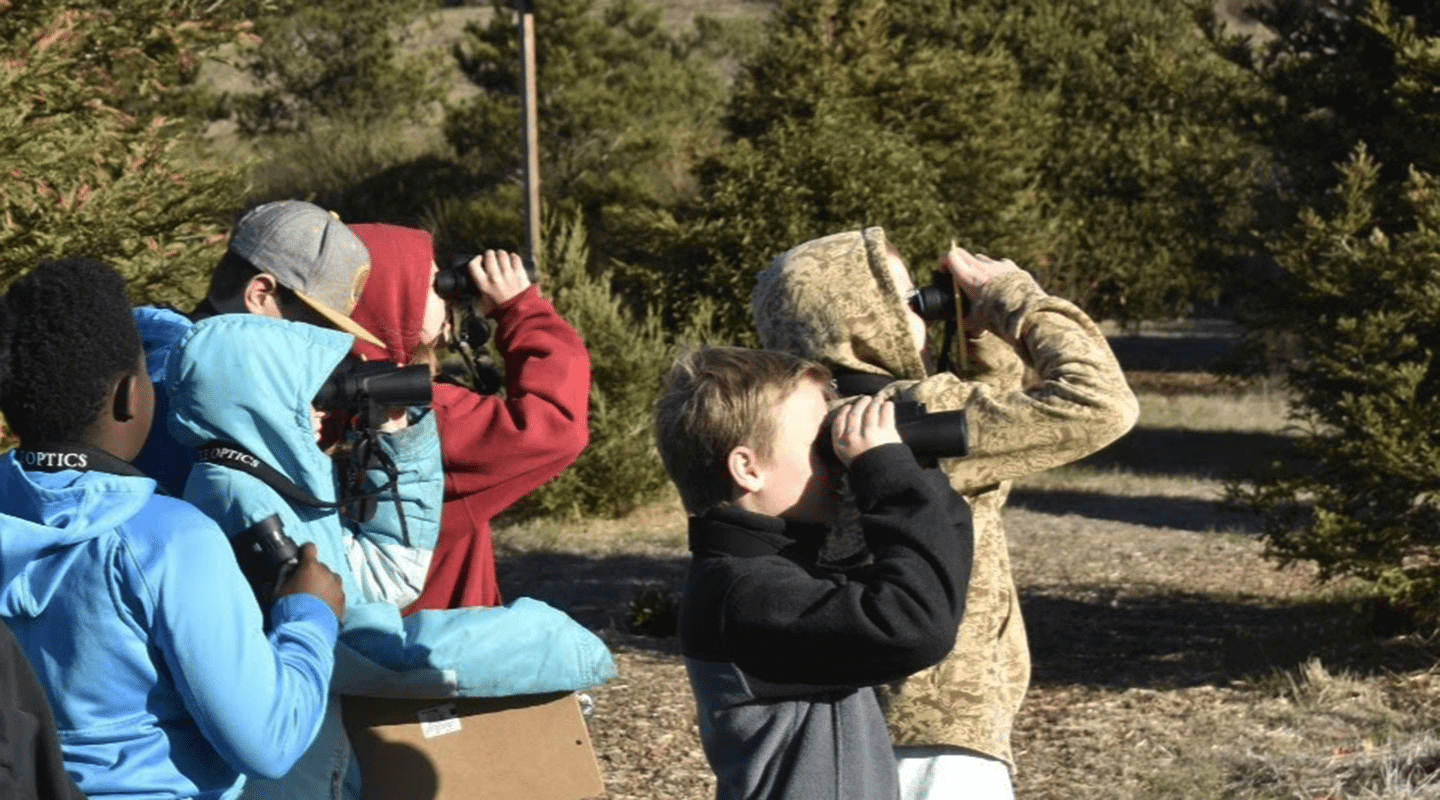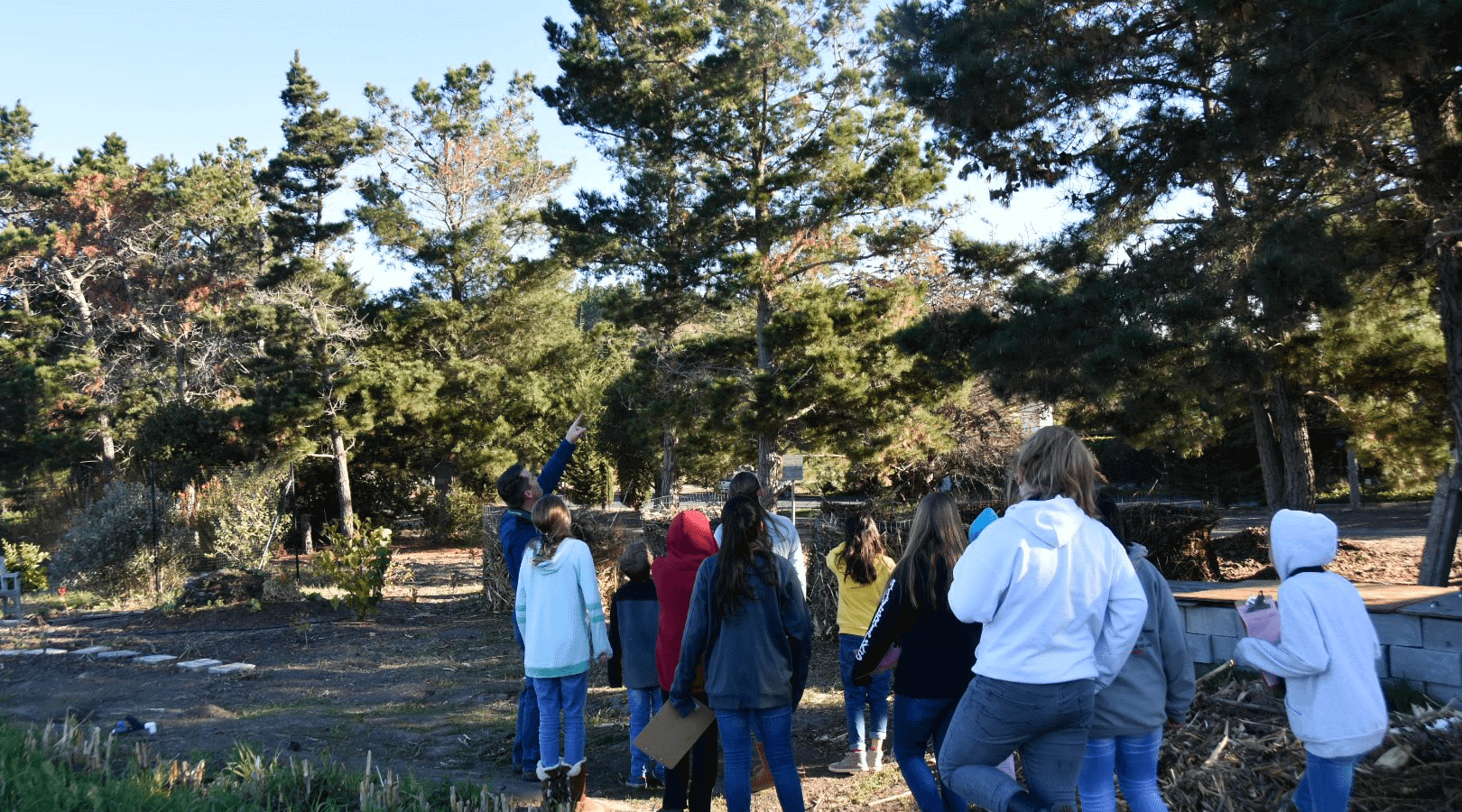ALSO READ: Fun Family Activity-Attracting Hummingbirds from Porch.com
“No one will protect what they don’t care about; and no one will care about what they have never experienced”
― David Attenborough
“Can you see the small gray bird on the third post in the field?” asks Audubon volunteer Paul Fenwick, as students fumble with their binoculars to spot the little gray bird. As soon as one student spots it, it flies toward us to the top of a small cottonwood tree, allowing students to observe its black mask and hooked beak. As students describe and record the sighting on their data sheets, Fenwick identifies the bird as a Loggerhead Shrike and explains how it relies on open fields to hunt. Shrikes kill and store their prey by impaling it on a small pointed branch or barbed wire. The Loggerhead Shrike was one of the 23 species of birds we documented on our forty-five minute hike around the school’s “habitat.” While spotting the Shrike was a special moment, birds in general are ubiquitous and thus are an amazing vehicle for students to learn about the interconnectedness of the environment.

I believe that students learn through experience, and outdoor experiences connect students to their physical place as well as reinforce essential classroom concepts. As a science teacher, I have witnessed the scientific process naturally unfold as students observe birds and ask questions: “What do the song sparrows eat?”, “Where do they live?”, “Where do they get water?”, and “Is the water clean?” Every observation leads to more questions! Resident and migrating birds rely on local food, shelter, and clean water. Because of this, birds provide many opportunities for students to research, observe, ask questions, make predictions, and collect data about their local environment. Humans love stories, and no matter how common, every bird has an interesting story. This year in science, I am using birds as an interwoven theme for students to learn about climate, weather, modeling, engineering, and scientific investigation. Students have already started collecting data on the birds we observe around our school’s habitat. On a typical walk outside, we record the type of bird, number seen, habitat type, weather, date, and time. Data is entered electronically, double-checked by a local Audubon member, then added to the eBird citizen science website. Using eBird adds importance to their work; our data will contribute to a global database used by scientists around the world to study issues such as climate change. The eBird database is huge, and contains years of data about bird sightings. With a little practice on eBird, middle school students can begin using citizen science data to study, question, and predict migration patterns of birds seen around our school.
On our bird walk around the habitat the students learned that Loggerhead Shrike populations are on the decline. Between 1966 and 2015 the numbers of this beautiful little bird have declined about three percent each year, culminating to almost 80%! While there is not just one thing to blame for their decline, many factors are linked to habitat loss and poor habitat health. When describing the Loggerhead Shrike situation, Fenwick sadly tells the students that this bird could disappear in their lifetime if we do not make an effort to protect its environment. News and data about the environment can be overwhelming, however, as a parent and a teacher I have hope for future generations. There is momentum for change, and there are many opportunities and resources for teachers at all levels to incorporate environmental literacy into the classroom. In 2015, California State Superintendent of Public Instruction Tom Torlakson released a Blueprint for Environmental Literacy that promotes environmental literacy for all students in California. The Next Generation Science Standards, Environmental Principles and Concepts, and the History–Social Science Framework provide teachers with many options to integrate environmental literacy into the curriculum. Finally, the CREEC Network connects teachers with many local organizations and resources that provide high-quality curriculum and instruction.

I am lucky that my school district supports environmental literacy. I am also fortunate to work with local organizations like MEarth and the Monterey Audubon with outdoor lessons. With the help of the MEarth staff, our students have many opportunities to learn about native plants and animals, gardening, and animal tracking. The curriculum and ideas put out by the Cornell Lab of Ornithology motivate me to get my classes outside. Lastly, I am continually inspired by all the great things that are happening in Green Ribbon and Ocean Guardian Schools. I teach about birds because they allow students to connect with, learn, and care about their environment. I teach about birds because, like humans, they are dependent on a clean, healthy environment. I teach about birds because there is a wealth of resources and support that allow students to experience top-notch lessons. Finally, I teach about birds because I believe that students can make a difference.
It is not all doom and gloom for the Loggerhead Shrike. These birds have a relatively high reproductive rate and can bounce back if we make an effort to conserve their habitat. How will the Loggerhead Shrike’s story end? I believe that our students can and will make the effort to protect the environment for the birds, for the plants, for the ocean, and for future generations of humans.


3 Responses
What a fascinating, interesting, important, relevant enterprise you are passionately involved in !!! It’s heartening to witness such excellent teaching, that combines your expertise, creativity, connections that enhance the environmental knowledge and
future of so many eager students who will in their lives expand on the lessons they’ve
;earned.
Darrell, I can’t be more pleased with your approach to teaching science. You’ve always been a proponent of the hands-on approach, and now you’ve taken it to the next level. Your students will walk away with, not only a deep understanding of the way things work, but also a real positive emotional connection that they get to keep all of their lives!
Hi!
I hope you’re having a wonderful day! It is excellent to e-meet you ; I’m Julio from Porch.com. I was browsing your site, and I loved the content on it!
; I’m Julio from Porch.com. I was browsing your site, and I loved the content on it!
I did not grow up being considerate of the environment; I became considerate as a young adult. I look back now, and I would have loved to have done more family activities that involved nature; maybe that would have made me more conscious early on. The most I ever did was go camping, and I loved it.
In these last few years, I have tried many nature projects. One of the most fun and creative for me was learning to attract hummingbirds. They are fun and intriguing little creatures; my nephews would tell you they also agree! That is why I decided to write an article topic about them. The article I wrote is; Fun Family Activity-Attracting Hummingbirds.
I shared it as an attachment, so you could give it a read if you would like. Let me know what you think about it if possible, and If you like it, I wanted to ask if you would be interested in adding it to your Why I Teach About Birds as a resource link. It does have some great information for your readers and community.
If you are interested, here is the link: https://porch.com/advice/fun-family-activity-attracting-hummingbirds
Many thanks for considering my request. I hope to hear from you soon!
PS: If you think I’m missing important info you would like to add, please let me know. You are also welcomed to use the article as a guest post. You can find it attached in a word document ready to go!
Best wishes,